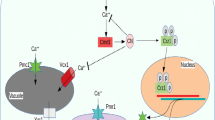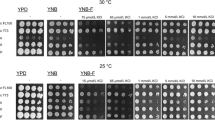Abstract
Some aspects of the cellular responses to cadmium were extensively investigated in the yeast Rhodotorula sp. Y11. Scanning electron microscopy indicated that accumulation of cadmium in the Y11 did not cause any visible effects on cell morphology. More than 20% yeast cells still showed viability after 15 h of cadmium accumulation under 100 mg l−1 cadmium concentration, and transmission electron microscopy analysis showed that plasmolysis and thickened cell wall were not observed in all of the cells. In the presence of cadmium, the activities of superoxide dismutase (SOD) and catalase (CAT) were all greater than the control, but the increase was in a dose-independent manner. Changes in SOD and CAT activities were also dependent on the time of exposure. Therefore, it suggests that antioxidative defenses play an important role in cadmium tolerance in Rhodotorula sp. Y11. Nondenaturing polyacrylamide gels revealed only one SOD isoforms in Y11 even under exposure to cadmium.




Similar content being viewed by others
References
Abe F, Miura T, Nagahama T, Inoue A, Usami R, Horikoshi K (2001) Isolation of a highly copper-tolerant yeast, Cryptococcus sp, from the Japan Trench and the induction of superoxide dismutase activity by Cu2+. Biotechnol Lett 23:2027–2034
Adamis PDB, Gomes DS, Pereira MD, de Mesquita JF, Pinto MLCC, Panek AD, Eleutherio ECA (2004) The effect of superoxide dismutase deficiency on cadmium stress. J Biochem Mol Toxicol 18:12–17
Aebi HE (1983) Catalase. In: Bergmeyer HU (ed) Methods of enzymatic analysis, vol III, 3rd edn. Verlag Chemie, Weinheim, pp 273–286
Beauchamp C, Fridovich I (1971) Superoxide dismutase: improved assays and an assay applicable to acrylamide gels. Anal Biochem 44:276–287
Blackwell KJ, Singleton I, Tobin JM (1995) Metal cation uptake by yeast: a review. Appl Microbiol Biotechnol 43:579–584
Bradford MM (1976) A rapid sensitive method for the quantitation of protein utilizing the principle of protein-dye binding. Anal Biochem 72:248–254
Bustard M, Donnellan N, Rollan A, McHale AP (1997) Studies on the biosorption of uranium by a thermotolerant, ethanol-producing strain of Kluyveromyces marxianus. Bioproc Eng 17:45–50
Chen T, Li W, Schulz PJ, Furst A, Chien PK (1995) Induction of peroxisome proliferation and increase of catalase activity in yeast, Candida albicans, by cadmium. Biol Trace Elem Res 50:125–133
Cho DH, Kim EY (2003) Characterization of Pb2+ biosorption from aqueous solution by Rhodotorula glutinis. Bioproc Biosyst Eng 25:271–277
De Silóniz MI, Balsalobre L, Alba C, Valderrama MJ, Peinado JM (2002) Feasibility of copper uptake by the yeast Pichia guilliermondii isolated from sewage sludge. Res Microbiol 153:173–180
Doshi H, Ray A, Kothari IL (2007) Biosorption of cadmium by live and dead Spirulina: IR spectroscopic, kinetics, and SEM studies. Curr Microbiol 54:213–218
Fridovich I (1983) Superoxide radical: an endogenous toxicant. Annu Rev Pharmacol Toxicol 23:239–257
Fujs Š, Gazdag Z, Poijšak B, Stibilj V, Milačič R, Pesti M, Raspor P, Batič M (2005) The oxidative stress response of the yeast Candida intermedia to copper, zinc, and selenium exposure. Basic Microbiol 45:125–135
Gadd GM, Mowll JL (1983) The relationship between cadmium uptake, potassium release and viability in Saccharomyces cerevisiae. FEMS Microbiol Lett 16:45–48
Geslin C, Llanos J, Prieur D, Jeanthon C (2001) The manganese and iron superoxide dismutases protect Escherichia coli from heavy metal toxicity. Res Microbiol 152:901–905
Goddard PA, Bull AT (1989) Accumulation of silver by growing and non-growing populations of Citrobaeter intermedius B6. Appl Microbiol Biotechnol 31:314–319
Gomes DS, Fragoso LC, Riger CJ (2002) Regulation of cadmium uptake by Saccharomyces cerevisiae. Biochim Biophys Acta 1573:21–25
Hernández-Saavedra NY (2003) Cu, Zn superoxide dismutase in Rhodotorula and Udeniomyces spp isolated from sea water: cloning and sequencing the encoding region. Yeast 20:479–492
Hwang CS, Baek YU, Yim HS, Kang SO (2003) Protective roles of mitochondrial manganese containing superoxide dismutase against various stresses in Candida albicans. Yeast 20:929–941
Kapoor A, Viraraghavan T (1995) Fungal biosorption: an alternative treatment option for heavy metal bearing wastewaters A review. Bioresour Technol 53:195–206
Kierans M, Staines AM, Bennett H, Gadd GM (1991) Silver tolerance and accumulation in yeasts. Biol Metals 4:100–106
Li ZJ, Yuan HL (2006) Characterization of cadmium removal by Rhodotorula sp Y11. Appl Microbiol Biotechnol 73:458–463
Li ZJ, Yuan HL, Hu XD (2008) Cadmium-resistance in growing Rhodotorula sp Y11. Bioresour Technol 99:1339–1344
Malik A (2004) Metal bioremediation through growing cells. Environ Int 30:261–278
Mannazzu I, Guerra E, Ferretti R, Pediconi D, Fatichenti F (2000) Vanadate and copper induce overlapping oxidative stress responses in the vanadate-tolerant yeast Hansenula polymorpha. Biochim Biophys Acta 1475:151–156
Marklund S, Marklund G (1974) Involvement of the superoxide anionradical in the autoxidation of pyrogallol and a convenient assay for superoxide dismutase. Bur J Biochem 47:469–474
Miura T, Abe F, Inoue A, Usami R, Horikoshi K (2002) Superoxide dismutase is involved in high tolerance to copper in the deep-sea yeast, Cryptococcus sp N6. Biotechnol Lett 24:1069–1074
Moore MM, Breedveld MW, Autor AP (1989) The role of carotenoids in preventing oxidative damage in the pigmented yeast, Rhodotorula mucilaginosa. Arch Biochem Biophys 270:419–431
Nies DH (1999) Microbial heavy-metal resistance. Appl Microbiol Biotechnol 51:730–750
Orozco MR, Hernandez-Saavedra NY, Valle FA, Gonzalez BA, Ochoa JL (1998) Cell yield and superoxide dismutase activity of the marine yeast Debaryomyces hansenni under different culture conditions. J Mar Biotechnol 6:255–59
Park JK, Lee JW, Jung JY (2003) Cadmium uptake capacity of two strains of Saccharomyces cerevisiae cells. Enzyme Microb Tech 33:371–378
Paš M, Milačič R, Drašlar K, Pollak N, Raspor P (2004) Uptake of chromium (III) and chromium (VI) compounds in the yeast cell structure. BioMetals 17:25–33
Pereira SIA, Lima AIG, de Figueira EMAP (2006) Screening possible mechanisms mediating cadmium resistance in Rhizobium leguminosarum bv. viciae isolated from contaminated Portuguese soils. Microbial Ecol 52: 176–186
Perkins J, Gadd GM (1993) Accumulation and intracellular compartmentation of lithium ions in Saccharomyces cerevisiae. FEMS Microbiol Lett 107:255–260
Romandini P, Tallandini L, Beltramini M, Salvato B, Manzano M, de Bertoldi M, Rocco GP (1992) Effects of copper and cadmium on growth, superoxide dismutase and catalase activities in different yeast strains. Comp Biochem Physiol C 103:255–262
Salinas E, Elorza de Orellano M, Rezza I (2000) Removal of cadmium and lead from dilute aqueous solutions by Rhodotorula rubra. Bioresour Technol 72:107–112
Sanità di Toppi L, Gabbrielli R (1999) Response to cadmium in higher plants. Environ Exp Bot 41:105–130
Schmidt A, Schmidt A, Haferburg G, Kothe E (2007) Superoxide dismutases of heavy metal resistant streptomycetes. J Basic Microbiol 47:56–62
Schroeder WA, Johnson EA (1993) Antioxidant role of carotenoids in Phaffia rhodozyma. J Gen Microbiol 139:907–912
So NW, Rho JY, Lee SY, Hancock IC, Kim JH (2001) A lead-absorbing protein with superoxide dismutase activity from Streptomyces subrutilus. FEMS Microbiol Lett 194:93–98
Soares EV, Duarte APRS, Boaventura RA, Soares HMVM (2002) Viability and release of complexing compounds during accumulation of heavy metals by a brewer’s yeast. Appl Microbiol Biotechnol 58:836–841
Srivastava S, Thakur IS (2006) Biosorption potency of Aspergillus niger for removal of chromium (VI). Curr Microbiol 53:232–237
Strandberg GW, Shumate SE, Parrott JR (1981) Accumulation of uranium by Saccharomyces cerevisiae and Pseudomonas aeruginosa Microbial cells as biosorbents for heavy metals. Appl Environ Microbiol 41:237–245
Suh JH, Yun JW, Kim DS (1998) Comparison of Pb2+ characteristics between live and dead cells of Saccharomyces cerevisiae and Aureobasidium pullulans. Biotechnol Lett 20:247–251
Vido K, Spector D, Lagniel G, Lopez S, Toledano MB, Labarre J (2001) A Proteome analysis of the cadmium response in Saccharomyces cerevisiae. J Biol Chem 276:8469–8474
Vieira RH, Volesky B (2000) Biosorption: a solution to pollution. Int Microbiol 3:17–24
Volesky B, May H, Holan ZR (1993) Cadmium biosorption by Saccharomyces cerevisiae. Biotechnol Bioeng 41:826–829
Wang NF, Yuan HL, Ying JY (2004) Characteristics of Cd2+ accumulation by a yeast strain isolated from mine soil. J Agro Environ Sci 23:674–676 (In Chinese)
Yuan HL, Li ZJ, Ying JY, Wang ET (2007) Cadmium(II) removal by a hyperaccumulator fungus Phoma sp F2 isolated from blende soil. Curr Microbiol 55:223–227
Zapotoczny S, Jurkiewicz A, Tylko G, Anielska T, Turnau K (2007) Accumulation of copper by Acremonium pinkertoniae, a fungus isolated from industrial wastes. Microbiol Res 162:219–228
Acknowledgements
This study was financially supported by the Major State Basic Research Development Program: Study on the Environmental Pollution Mechanisms and Control Principles in Beijing and Surrounding Area (G1999045709) and Tai Hu Project (No. BK 2007741) from Jiangsu Science and Technology.
Author information
Authors and Affiliations
Corresponding author
Rights and permissions
About this article
Cite this article
Li, Z., Yuan, H. Responses of Rhodotorula sp. Y11 to cadmium. Biometals 21, 613–621 (2008). https://doi.org/10.1007/s10534-008-9147-6
Received:
Accepted:
Published:
Issue Date:
DOI: https://doi.org/10.1007/s10534-008-9147-6




